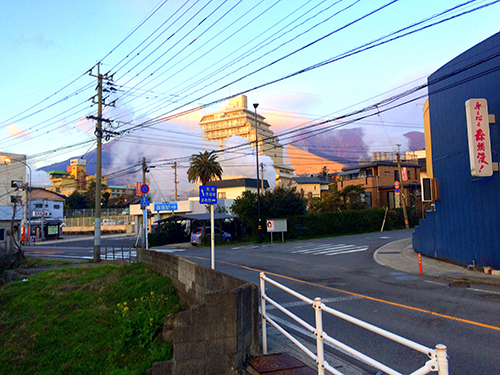By Kimberly Burnett
Earlier this year I had the opportunity to work with an interdisciplinary team at the Research Institute of Humanity and Nature (RIHN) on a Visiting Research Fellowship examining “Human-Environmental Security in Asia-Pacific Ring of Fire: Water-Energy-Food Nexus.” Our objective was to design research frameworks for conducting water-energy-food economic analyses for three study sites in Japan: Obama, Beppu, and Otsuchi.
Synergies and tradeoffs among water, energy use, and food production should be considered by stakeholders and decision-makers looking to maximize the benefit from each resource. Economics can help to identify these tradeoffs by quantifying the benefits and costs of water, energy, and food-related projects over long planning horizons, as well as by optimizing allocations of these resources over multiple uses. During my research fellowship we developed frameworks for economic analysis of the water-energy–food nexus using examples from three case studies in Japan: water allocation over multiple uses in Obama, renewable energy production in Beppu, and construction of a dike in Otsuchi. Each of these case studies involves choices that will affect inherent linkages between water, energy, and food in each system. Failing to recognize these tradeoffs can result in sub-optimal allocation of resources with respect to the economy, the ecology, society and culture.

Obama is a city on the Sea of Japan in Fukui Prefecture, where groundwater is an important resource for a variety of uses including domestic use, melting snow, and fishery production (via submarine groundwater discharge). Over-allocation of groundwater towards above ground uses has implications on the important fishery resource near shore. An economically efficient solution is characterized by groundwater utilization paths over time that maximize net benefits across uses, explicitly considering how using water for one purpose reduces the availability of water for other purposes. Aside from the direct tradeoff between groundwater and the fishery, a key variable in the model is the price of energy, which affects the costs of both groundwater pumping and alternative snow-melting techniques. The team developed a bioeconomic optimization model that can be used to solve for optimal allocation of groundwater to each of these three uses over time.

Beppu is a city in Oita Prefecture best known for its high concentration of natural hot springs (“onsen”). Onsen are an important economic and cultural resource, whose use has significant implications on the surrounding society and ecology. Interest in small-scale renewable energy production using hot water and steam from the onsen (“onsen hatsuden”) has increased in recent years, especially following the Tokohu earthquake/ tsunami/ nuclear meltdown disaster of 2011. There are two primary types of onsen hatsuden being developed in Beppu: binary systems which are more productive but generate larger social and ecological damages, and the smaller scale yukemuri hatsuden which have a much lower production capacity but are less harmful to the surrounding ecosystem and society. We designed an economic approach to comparing the benefits and costs of each system.

Beppu is a city in Oita Prefecture best known for its high concentration of natural hot springs (“onsen”). Onsen are an important economic and cultural resource, whose use has significant implications on the surrounding society and ecology. Interest in small-scale renewable energy production using hot water and steam from the onsen (“onsen hatsuden”) has increased in recent years, especially following the Tokohu earthquake/ tsunami/ nuclear meltdown disaster of 2011. There are two primary types of onsen hatsuden being developed in Beppu: binary systems which are more productive but generate larger social and ecological damages, and the smaller scale yukemuri hatsuden which have a much lower production capacity but are less harmful to the surrounding ecosystem and society. We designed an economic approach to comparing the benefits and costs of each system.
BLOG POSTS ARE PRELIMINARY MATERIALS CIRCULATED TO STIMULATE DISCUSSION AND CRITICAL COMMENT. THE VIEWS EXPRESSED ARE THOSE OF THE INDIVIDUAL AUTHORS. WHILE BLOG POSTS BENEFIT FROM ACTIVE UHERO DISCUSSION, THEY HAVE NOT UNDERGONE FORMAL ACADEMIC PEER REVIEW.